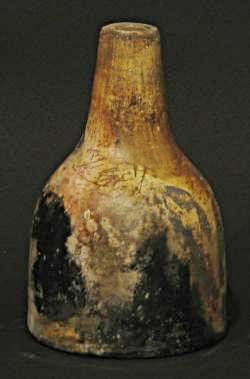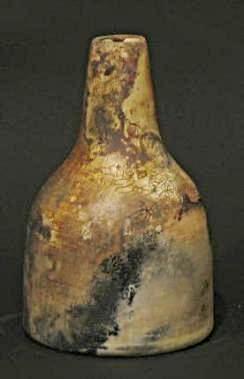In my last post I wrote about the use of cobalt carbonate to make a blue terra sigillata; here in the picture below (figure 1) is a different pot — but same white clay body and same cone 06 bisque — burnished with a pink terra sig, which was made from a white Tennesee ball clay base using red iron oxide as the colorant. As is in the case of the blue pots, the underlying pinkish red tint influences the final hues of the color flashes; here it gives the pot a warm but muted, almost aged look overall.

Below is another view of the same pot (figure 2), which, incidentally, stands 5 1/2 inches (14 cm) tall, just like the two blue pots described in the previous post. Notice the crazing (tiny little cracks) of the terra sig, which, while a technical defect — I probably had applied the terra sig a bit too early, i.e. while the pot was still relatively wet, or too thickly — here it actually appears to have contributed positively to the character of the piece by giving it an ancient, weathered look.

There were two items listed in my notebook as packing material for this piece: (1) salted burlap wrapped around the pot, and (2) “chore-boy” copper net on the outside. The salt from the salted burlap is probably what gives the pot an orange-brown tone over all; as to the copper, I’m not sure if it had any effect. Sometimes copper will show up as a flat, quasi-metallic, brown-black band on a pot — which we do have a few on this pot, though not really easily visible in the two photos above.
Okay, if you really want to look for them, they are the three skinny brown bands on the right side of the pot in figure 1, and the partially visible horizontal one at the left edge of the pot in figure 2.